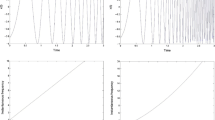Abstract
The problem of automatic parasitic chirp components detection and suppression in a digital signal is considered. The detection is based on the calculation of the discrete Wigner distribution accompanied by the Hough transform. The filtration is achieved by a series of discrete fractional Fourier transforms converting the signal to special coordinates, where the entire energy of the parasitic signals is accumulated at a few samples and then reset. The main novelty is the utilization of new construction of discrete fractional Fourier transform coordinated with the discrete Wigner distribution. The advantages of the proposed approach are illustrated by the simulations.






Similar content being viewed by others
References
T. Alieva, V. Lopez, F. Agullo-Lopez, L.B. Almeida, The fractional Fourier transform in optical propagation problems. J. Mod. Opt. 41, 1037–1044 (1994)
O.A. Alkishriwo, L.F. Chaparro, A. Akan, Signal separation in the Wigner distribution domain using fractional Fourier transform, in Proceedings of the 19th European Signal Processing Conference (2011), pp. 1879–1883
S. Barbarossa, Analysis of multicomponent LFM signals by a combined Wigner-Hough transform. IEEE Trans. Signal Process. 43(6), 1511–1515 (1995)
Ç. Candan, On higher order approximations for Hermite-Gaussian functions and discrete fractional Fourier transforms. IEEE Signal Process. Lett. 14(10), 699–702 (2007)
Ç. Candan, M.A. Kutay, H.M. Ozaktas, The discrete fractional Fourier transform. IEEE Trans. Signal Process. 48(5), 1329–1337 (2000)
D.S.K. Chan, A non-aliased discrete-time Wigner distribution for time-frequency signal analysis, in IEEE International Conference on Acoustics, Speech, and Signal Processing, Paris (1982), pp. 1333–1336
T.A.C.M. Claasen, W.F.G. Mecklenbräuker, The Wigner distribution: a tool for time-frequency signal analysis; part II: discrete time signals. Philips J. Res. 35, 276–300 (1980)
B.W. Dickinson, K. Steiglitz, Eigenvectors and functions of the discrete Fourier transform. IEEE Trans. Acoust. Speech Signal Process. 30, 25–31 (1982)
R.G. Dorsch, A.W. Lohmann, Y. Bitran, D. Mendlovic, H.M. Ozaktas, Chirp filtering in the fractional Fourier domain. Appl. Opt. 33(32), 7599–7602 (1994)
D. Dragoman, Applications of the Wigner distribution function in signal processing. EURASIP J. Appl. Signal Process. 2005(10), 1520–1534 (2005)
R.O. Duda, P.E. Hart, Use of the Hough transformation to detect lines and curves in pictures. Commun. ACM 15(1), 11–15 (1972)
A.Y. Erdogan et al., FMCW signal detection and parameter extraction by cross Wigner-Hough transform. IEEE Trans. Aerosp. Electron. Syst. 53(1), 334–344 (2017)
F.A. Grunbaum, The eigenvectors of the discrete Fourier transform: a version of the Hermite functions. J. Math. Anal. Appl. 88, 355–363 (1982)
M.T. Hanna, N.P. Seif, W.A.E.M. Ahmed, Discrete fractional Fourier transform based on the eigenvectors of tridiagonal and nearly tridiagonal matrices. Dig. Signal Process. 18(5), 709–727 (2008)
C. Levy, M. Pinchas, Y. Pinhasi, A new approach for the characterization of nonstationary oscillators using the Wigner–Ville distribution. Math. Probl. Eng. (2018). https://doi.org/10.1155/2018/4942938
V. Namias, The fractional order Fourier transform and its application to quantum mechanics. J. Inst. Appl. Math. 25, 241–265 (1980)
H.M. Ozaktas, O. Arikan, M.A. Kutay, G.B. Bozdagi, Digital computation of fractional Fourier-transform. IEEE Trans. Signal Process. 44, 2141–2150 (1996)
H.M. Ozaktas, Z. Zalevski, M.A. Kutay, The Fractional Fourier Transform with Applications in Optics and Signal Processing (Wiley, New York, 2001)
F. Peyrin, R. Prost, A unified definition for the discrete-time, discrete-frequency, and discrete-time/frequency Wigner distributions. IEEE Trans. Acoust. Speech Signal Process. 34(4), 858–867 (1986)
A. Serbes, L. Durak-Ata, The discrete fractional Fourier transform based on the DFT matrix. Signal Process. 91, 571–581 (2011)
R. Torres, E. Torres, Fractional Fourier analysis of random signals and the notion of α-stationarity of the Wigner–Ville distribution. IEEE Trans. Signal Process. 61, 1555–1560 (2013)
E. Wigner, On the quantum correction for thermodynamic equilibrium. Phys. Rev. 40, 749–759 (1932)
Z. Yin, W. Chen, A new LFM-signal detector based on fractional Fourier transform. EURASIP J. Adv. Signal Process. 1, 876282 (2010)
Author information
Authors and Affiliations
Corresponding author
Additional information
Publisher's Note
Springer Nature remains neutral with regard to jurisdictional claims in published maps and institutional affiliations.
Rights and permissions
About this article
Cite this article
Golubtsov, P.E., Morozov, I.I. Automatic Detection and Suppression of Parasitic Chirp Signals in the Intermediate Time–Frequency Domain. Circuits Syst Signal Process 39, 3035–3045 (2020). https://doi.org/10.1007/s00034-019-01302-y
Received:
Revised:
Accepted:
Published:
Issue Date:
DOI: https://doi.org/10.1007/s00034-019-01302-y




